London

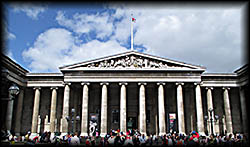
British Museum
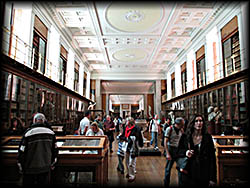
Enlightenment Room in the British Museum
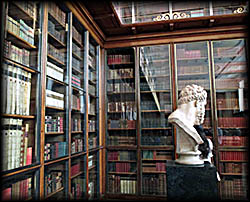
Books in the Enlightenment Room
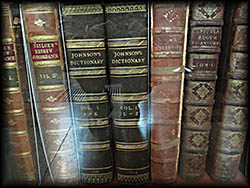
In the British Museum you can see the very first English dictionary ever written (and printed) by Samuel Johnson.

These ivory figurines in the British Museum look like aliens to me.

Nereid Monument in the British Museum
The British have two classes of buses: the bus proper and the coach. This I learned while on a paid tour of the city when our guide informed my mother and me that we’d boarded a coach, not a bus. “What’s the difference?” we asked. The answer: “A bus picks up and drops off people on a dedicated route. A coach doesn’t.” Or words to that effect.
This we had learned on our second of two full days in London. On our first we went to the British Museum. When planning this venture from home, I had decided to go by bus because I’d read that it’s a cheap way to see the city. When we arrived in London, the locals disabused us of that notion. The best way to move about London, we were told, is via the Tube, or local subway. Although a day pass for this system cost us £12 each—about $18.27—it still saved us a lot of money. A one way cab ride from our hotel to the British Museum would’ve been about £74.28, or nearly $114! To get onto the Tube we took a short and free bus ride from the hotel to Hatton Cross Station. Forty minutes later we arrived at our stop. Had we taken the bus as I’d initially planned, it would have taken about two hours and forty minutes.
I had worried that once off the Tube we’d have trouble locating the British Museum because in a big city it’s easy to get turned around. In London you need not concern yourself about this. There are signs pointing to a different places everywhere, so we never had a problem finding what we wanted.
This we had learned on our second of two full days in London. On our first we went to the British Museum. When planning this venture from home, I had decided to go by bus because I’d read that it’s a cheap way to see the city. When we arrived in London, the locals disabused us of that notion. The best way to move about London, we were told, is via the Tube, or local subway. Although a day pass for this system cost us £12 each—about $18.27—it still saved us a lot of money. A one way cab ride from our hotel to the British Museum would’ve been about £74.28, or nearly $114! To get onto the Tube we took a short and free bus ride from the hotel to Hatton Cross Station. Forty minutes later we arrived at our stop. Had we taken the bus as I’d initially planned, it would have taken about two hours and forty minutes.
I had worried that once off the Tube we’d have trouble locating the British Museum because in a big city it’s easy to get turned around. In London you need not concern yourself about this. There are signs pointing to a different places everywhere, so we never had a problem finding what we wanted.

We wanted to see the Rosetta Stone above all else, but so did everyone else. A thick crowd surrounded it, making an up-close examination a bit challenging. I decided not to try to barge into that mass, but rather crept up to its side where few people lingered. Now I saw something unexpected: someone had engraved English letters into the stone’s side, although I couldn’t make out what they were. When I got home I e-mailed the British Museum about it but never received a reply.

Someone engraved English letters into the side of the Rosetta Stone, although I have no idea what it says or why it is there.
We wandered about almost at random, letting the museum reveal itself in an unplanned manner. In a room filled with treasures from China, I decided to find a Ming vase so I could see just what makes one of these so valuable. I came across several and quickly determined that to the untrained eye, they look exactly like vases from the previous and succeeding Chinese dynasties.
With so many objects to see in a matter of hours, one has to pick and choose what to take a closer look at. One set of Egyptian artifacts caught my eye because of their peculiar design. In his 1968 book Chariots of the Gods? Unsolved Mysteries of the Past, Erich von Däniken argued that aliens had created the wonders of the ancient world, including the Egyptian pyramids. While I consider this utter nonsense, I must admit that if Däniken saw these, he would yell with glee: “See, I told you so!” They look like the sort of aliens that might try to abduct you on a lonely road.
One could spend days going through the museum’s halls and rooms in no small part because of its immense size. Some of its rooms are large enough to accommodate entire buildings, such as number 17 on the ground floor that houses the Nereid Monument, a Lykian tomb from Xanthos in southwestern Turkey. I wondered at the time just how the museum had acquired it. I suspected it had been looted. I looked it up later and, sure enough, a British subject named Sir Charles Fellows shipped it off to Britain in 1841 when no one was looking. The museum is in fact filled with many looted objects, and I imagine if you returned them to all their rightful owners, about three-fourths of the items currently on display, the Rosetta Stone included, would disappear.
With so many objects to see in a matter of hours, one has to pick and choose what to take a closer look at. One set of Egyptian artifacts caught my eye because of their peculiar design. In his 1968 book Chariots of the Gods? Unsolved Mysteries of the Past, Erich von Däniken argued that aliens had created the wonders of the ancient world, including the Egyptian pyramids. While I consider this utter nonsense, I must admit that if Däniken saw these, he would yell with glee: “See, I told you so!” They look like the sort of aliens that might try to abduct you on a lonely road.
One could spend days going through the museum’s halls and rooms in no small part because of its immense size. Some of its rooms are large enough to accommodate entire buildings, such as number 17 on the ground floor that houses the Nereid Monument, a Lykian tomb from Xanthos in southwestern Turkey. I wondered at the time just how the museum had acquired it. I suspected it had been looted. I looked it up later and, sure enough, a British subject named Sir Charles Fellows shipped it off to Britain in 1841 when no one was looking. The museum is in fact filled with many looted objects, and I imagine if you returned them to all their rightful owners, about three-fourths of the items currently on display, the Rosetta Stone included, would disappear.
All the travel books and websites I’d read insisted you get the best U.S. to foreign currency exchange rate from ATM’s, so we’d only brought a small amount of foreign currency as ready cash with the idea of getting the rest of what we wanted locally. Before walking to the museum, we headed to the nearest ATM. It promptly denied our cards! This was the second time this morning. Before leaving our hotel, we’d tried using its ATM, and when that didn’t work, we figured that specific machine didn’t accept our cards. Now we knew for certain we had a bigger problem.
Panic started to set in. We couldn’t call our bank because our cell phones didn’t work in Europe, so I made a beeline for the first local bank I saw and asked for help. The very nice people there explained to us that we needed to find an international ATM that took American cards, which at the time used magnetic strips rather than the chip-based European ones. We would find such a machine at one of the many money exchange places in the area. After quite a bit of walking, we did so, but again our cards wouldn’t work. In desperation we exchanged what American money we had on us for British pounds, and while that would help, we still needed much more considering the high cost of everything in the city.
By now we’d wandered about for over two hours. Desperately in need of breakfast, we ate at a small café run by first generation Italians. Here I decided to test my regular credit card to see if it worked. To my relief, it did. At least we wouldn’t starve, but this didn’t help us from being cash poor. Still, with filled bellies and some light shining on our dark troubles, we headed for the British Museum.
This venerable place, established in 1753, displays objects showcasing the human’s race’s cultural history. It makes all other museums of its type, including the Smithsonian, look like amateurs. One room, for example, dedicates itself to exhibiting items to do with the Enlightenment. It must’ve had 5,000 objects on display.
Panic started to set in. We couldn’t call our bank because our cell phones didn’t work in Europe, so I made a beeline for the first local bank I saw and asked for help. The very nice people there explained to us that we needed to find an international ATM that took American cards, which at the time used magnetic strips rather than the chip-based European ones. We would find such a machine at one of the many money exchange places in the area. After quite a bit of walking, we did so, but again our cards wouldn’t work. In desperation we exchanged what American money we had on us for British pounds, and while that would help, we still needed much more considering the high cost of everything in the city.
By now we’d wandered about for over two hours. Desperately in need of breakfast, we ate at a small café run by first generation Italians. Here I decided to test my regular credit card to see if it worked. To my relief, it did. At least we wouldn’t starve, but this didn’t help us from being cash poor. Still, with filled bellies and some light shining on our dark troubles, we headed for the British Museum.
This venerable place, established in 1753, displays objects showcasing the human’s race’s cultural history. It makes all other museums of its type, including the Smithsonian, look like amateurs. One room, for example, dedicates itself to exhibiting items to do with the Enlightenment. It must’ve had 5,000 objects on display.
I’ve heard the argument that you can’t return items of cultural significance to their places of origin because the current people inhabiting those areas can’t be relied on to preserve them. While I don’t subscribe to this view, there are unfortunately times when it’s true. Examples abound. In 2001 the Taliban destroyed the giant statues of Buddha in Bamiyan. The Syrian army is destroying sites of cultural history in the ongoing Syrian Civil War. Islamic State sold what looted items it could and smashed those it couldn’t, although many of the larger ones destroyed were in truth worthless duplicates. So while I think looted items should be returned to their rightful places, I will admit it’s a good idea not to do so at a moment of turmoil.
About three hours into our visit to the museum, my lack of sleep—I think I’d maybe gotten six hours the night before, this after a very long flight—caught up with me. The adrenaline keeping me going had finally worn off, but I had so much more to see I didn’t want to stop. So I went to the overpriced museum café and there purchased a hot chocolate and brownie. I’ve had museum food before and didn’t find it impressive, but in this case both were tasty. Fifteen minutes later the mixture of sugar and caffeine and sitting down kicked in and gave me a resurgence of energy. We spent another hour exploring the museum, finishing our time there in the giftshop.
The next day we traveled to the pickup point for a day tour of London that we’d signed up for from the Viator Company. Despite having given ourselves two hours to get up, shower, and make our way to the pickup point, we nearly didn’t make it. This taught us that when travelling in London, one always needs to double the amount of time one thinks it will take to get somewhere.
About three hours into our visit to the museum, my lack of sleep—I think I’d maybe gotten six hours the night before, this after a very long flight—caught up with me. The adrenaline keeping me going had finally worn off, but I had so much more to see I didn’t want to stop. So I went to the overpriced museum café and there purchased a hot chocolate and brownie. I’ve had museum food before and didn’t find it impressive, but in this case both were tasty. Fifteen minutes later the mixture of sugar and caffeine and sitting down kicked in and gave me a resurgence of energy. We spent another hour exploring the museum, finishing our time there in the giftshop.
The next day we traveled to the pickup point for a day tour of London that we’d signed up for from the Viator Company. Despite having given ourselves two hours to get up, shower, and make our way to the pickup point, we nearly didn’t make it. This taught us that when travelling in London, one always needs to double the amount of time one thinks it will take to get somewhere.
We also visited, among other places, Coventry Garden and St. Paul’s Cathedral. When the tour ended, our guide gave us directions for the best way to return to our hotel via the Tube. After a short trip on the District Line, we transferred to the westbound train on the Piccadilly Line. Having used this the day before, we fully expected it to take us to Hatton Cross. When it reached Northfields, a few stops before this, everyone got off except us. One of our fellow passengers told us the train would go no farther and we needed to get off now. A minute later its doors closed and shortly thereafter it wandered off Lord knows where. We might well still be riding about had that Good Samaritan not helped us. To get on the train for Hatton Cross, we had to do nothing more than walk a few feet to the platform’s other side.
Because our hotel’s restaurant served nothing we wanted and had prices that seemed a bit extravagant, I went online to look for local eateries within walking distance. The instructions I received said we need only go around the block to find a strip of restaurants. Fifteen minutes later it became apparent we’d gone the wrong way. Undaunted, we kept going until we wandered in Harlington, a quaint rural-looking settlement we mistook for a village. It is, in truth, one of London’s outermost boroughs. Here we found a pub at which we asked the fellow standing outside the door if it served food. No, he said, but come in and have a pint anyway. Sorry, we really wanted to eat. Well, then, he told us to keep going and you will find the White Hart, which did serve food. After that, please come back and have a drink (we didn’t).
The White Hart is a beautiful pub that has served its community since, if my memory serves me correctly, the 1920s. I’d always heard authentic English food is bland and just plain awful, but we got a delicious meal that included chicken pie, some veggies, and mashed potatoes and gravy. After paying our bill, we returned to our hotel and began packing. The next morning we’d be heading to Belgium for tour of World War I sites. Those interested in reading about that trip can click here.🕜
Because our hotel’s restaurant served nothing we wanted and had prices that seemed a bit extravagant, I went online to look for local eateries within walking distance. The instructions I received said we need only go around the block to find a strip of restaurants. Fifteen minutes later it became apparent we’d gone the wrong way. Undaunted, we kept going until we wandered in Harlington, a quaint rural-looking settlement we mistook for a village. It is, in truth, one of London’s outermost boroughs. Here we found a pub at which we asked the fellow standing outside the door if it served food. No, he said, but come in and have a pint anyway. Sorry, we really wanted to eat. Well, then, he told us to keep going and you will find the White Hart, which did serve food. After that, please come back and have a drink (we didn’t).
The White Hart is a beautiful pub that has served its community since, if my memory serves me correctly, the 1920s. I’d always heard authentic English food is bland and just plain awful, but we got a delicious meal that included chicken pie, some veggies, and mashed potatoes and gravy. After paying our bill, we returned to our hotel and began packing. The next morning we’d be heading to Belgium for tour of World War I sites. Those interested in reading about that trip can click here.🕜
Of the many places the tour took us that day, the Tower of London was my favorite. Having read about it countless times over the years, I thought it was a single large tower surrounded by a wall. This is wrong. Its walls envelop a series of different towers, including the Bloody Tower where Richard III supposedly had his nephews murdered, and the White Tower, the oldest of the structures in the complex that was built by William the Conqueror.
Our Viator guide left us with one of the Tower’s yeomen warders—a beefeater—for a brief tour and an overview of the complex. This fellow’s lecture ended at the entrance to building that houses the Crown Jewels, which are scattered about in a series of rooms that culminate with the one containing the crown itself. After this we had about forty-five minutes to explore what we wanted to see before returning to the coach.
We chose the White Tower, which houses the Royal Armories collection, an excellent selection of historic weapons and armor, the latter including suits used by Henry VIII and Charles I. On the top floor a dragon named Keeper stands guard. Made out of artifacts found in the Tower (or, more likely, replicas of them), each part of this beastie represents a function for which the Tower once served. The telescopes, for example, symbolize the Royal Observatory once found here, the 2,000 silver and gold coins the former mint, and the 400 rubies the Jewel House.
I could have happily spent the whole day here, but our Viator tour had to move on to other places. When our group reassembled, several still hadn’t returned. A few drifted in the next minute, but one couple never showed up. Our guide, clearly distressed, waited another five minutes, then said we had to go on without them. (They later caught up with us on their own in another part of London.) We needed to hurry to see the changing of the guard at Buckingham Palace. Alas, this initial delay plus unexpected road construction caused us to miss it, although the outgoing guards did parade by us.
Our Viator guide left us with one of the Tower’s yeomen warders—a beefeater—for a brief tour and an overview of the complex. This fellow’s lecture ended at the entrance to building that houses the Crown Jewels, which are scattered about in a series of rooms that culminate with the one containing the crown itself. After this we had about forty-five minutes to explore what we wanted to see before returning to the coach.
We chose the White Tower, which houses the Royal Armories collection, an excellent selection of historic weapons and armor, the latter including suits used by Henry VIII and Charles I. On the top floor a dragon named Keeper stands guard. Made out of artifacts found in the Tower (or, more likely, replicas of them), each part of this beastie represents a function for which the Tower once served. The telescopes, for example, symbolize the Royal Observatory once found here, the 2,000 silver and gold coins the former mint, and the 400 rubies the Jewel House.
I could have happily spent the whole day here, but our Viator tour had to move on to other places. When our group reassembled, several still hadn’t returned. A few drifted in the next minute, but one couple never showed up. Our guide, clearly distressed, waited another five minutes, then said we had to go on without them. (They later caught up with us on their own in another part of London.) We needed to hurry to see the changing of the guard at Buckingham Palace. Alas, this initial delay plus unexpected road construction caused us to miss it, although the outgoing guards did parade by us.
View from the White Tower
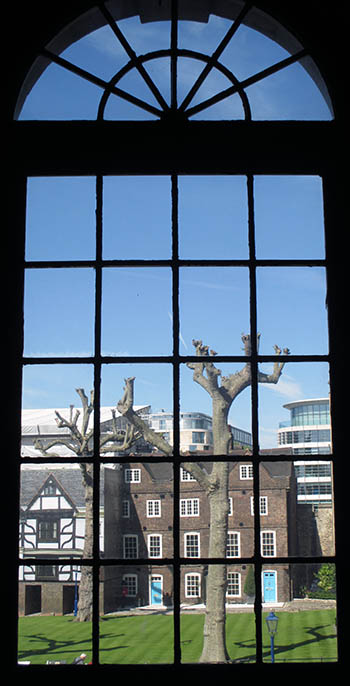

The Tower of London’s Traitor’s Gate

The clock at the British Parliament building that contains the bell known as Big Ben.
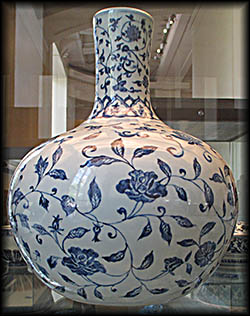
I have decided Ming vases such as this one in the British Museum look exactly the same as the preceding and succeeding dynasties.
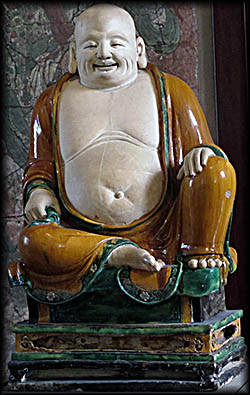
Buddha Figurine in the British Musuem
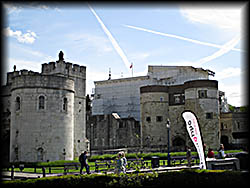
Tower of London
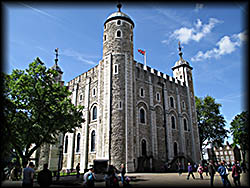
White Tower
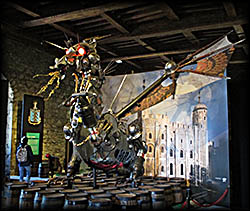
Keeper guards the top floor of the White Tower.